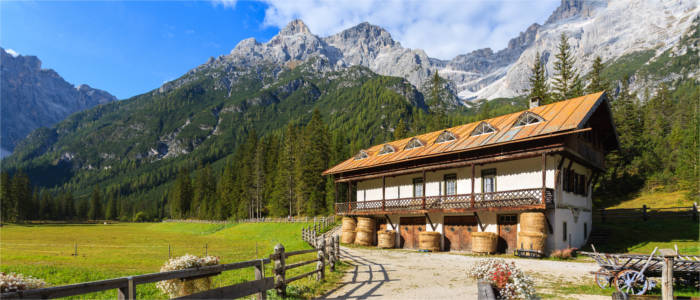Travel Offers
Travelmyne Featureprint
Distance
Italian Alps - A Magnificent Mountain Backdrop
People have always been fascinated by the Italian Alps with their magnificent peaks, breathtaking rock formations and romantic pastures. The famous military commander Hannibal tried to defeat the beautiful mountain range 218 BC and today many winter sports fans and hikers are drawn to the unique mountainous landscape.

Geography - A climatic divide of 4,000 metres of height in the heart of Europe
The Alps are a significant mountain range in the heart of Europe. They cover an area which is 200 kilometres wide and almost 1,200 kilometres long and extend over several countries (France, Monaco, Switzerland, Liechtenstein, Germany, Austria, Slovenia, Italy). In France and Italy, the mountain chain is divided into a central, eastern and western part. The Western Alps run from the Ligurian Sea to Mont Blanc in the Aosta Valley, the Central Alps extend to the Brenner Pass in South Tyrol and the Eastern Alps run as far as Slovenia. The Italian part of the Alps lies in the north of the country in the regions of the Aosta Valley, Lombardy, Piedmont and Friuli-Venezia Giulia. It accommodates countless mountain groups, glaciers and beautiful peaks with heights of over 4,000 metres. Its highest point is Mont Blanc, which is 4,810 metres high. The Alps constitute an important climatic divide in Europe, which separates the Atlantic climate zone from the temperate and the Mediterranean one. In this way, humid Atlantic air, cold masses of air coming from the north, dry and continental winds as well as warm air from the south determine the local weather.

Nature - Famous peaks surrounded by alpine vegetation
The Alps have a great number of mountain groups, chains and formations which are more than 4,000 metres above sea level. Well-known peaks in the Italian Alps, which are the destination of many hikers and mountaineers, are Mont Blanc (4,810 m), the Gran Paradiso (4,061 m) and the Matterhorn (4,478 m) in the Aosta Valley, the Tre Cime di Lavaredo (2,999 m) in South Tyrol and the Marmolada (3,343 m) in Trentino. The flora in the Alps differs depending on the altitude. Up to 2,000 metres of height, oak and spruce forests dominate the landscape, while shrubs (e.g. juniper, rhododendron), flowering plants (e.g. edelweiss, gentian) and meadows characterise the areas between 2,000 and 3,000 metres of height. At altitudes of over 3,000 metres of height, the vegetation is getting sparse and only grows on areas which are not covered in snow in summer. The animals which live at lower altitudes are mostly the same as the ones in the local lowland. However, many animals of in the Alps such as chamois, ibexes, marmots, snow voles or golden eagles have retreated to the areas above treeline.

Culture - Traditional farming culture
The name of the Alps is derived from the Alemannic word "Alp" ("pasture") but the mountain range also shares etymological characteristics with the word "alpine" (mountainous). In the course of history, a unique farming culture with magnificent farmhouses, Alpine languages (Ladin, Friulian, Romansh) and religious celebrations and customs developed in the Alpine regions. In addition, yodelling, folk music, Almabtrieb (driving of the cattle from the mountains into the valley) and Alpsegen ("Alpine blessing") are permanent features of the tradition in the Alpine regions. Customs and traditions are also present in the numerous descended legends and stories, which manifest the aesthetic image of the mountains in form of the romantic Alpine glow (the pink tone the mountains assume during sunrise and sunset), for example. The Italian Alps have been a tourist destination since the 19th century and constitute and impressive location, which is worth defeating. This relation between respect and conquest is symbolised by numerous summit crosses.

Experience - A natural atmosphere
The relaxed, natural atmosphere in the Alps captures many holidaymakers every year. They are fascinated by the breathtaking nature as well as the rural culture and traditional agriculture. The local cuisine, which is characterised by sausage and ham specialities, the charming rustic ambience and the hospitality of the Alpine population complete this natural experience.

Activities - A playground for active holidaymakers
The Italian Alps offer a great variety of leisure and sporting activities. The extraordinary landscape has a lot to offer for both travellers who are looking for relaxation and active holidaymakers. The latter definitely get their money's worth on holiday in the Italian Alps. Hiking, mountaineering, cycling, mountain biking, motorcycling and doing winter sports are favoured activities. In the last few years, winter sports have become more popular than summer leisure activities.

Information
The Italian Alps are a popular holiday destination throughout the year - as a skiing paradise in winter, as a hiking and climbing oasis in summer. Good travel offers are bookable over different travel operators like TUI. Regardless of the season, travellers should bring appropriate footwear and clothing. In case of an emergency, you can call 118, the telephone number of Italy's mountain rescue.
The Italian Alps attract great numbers of holidaymakers, especially sports fans and lovers of nature. Impressive mountains, a native landscape as well as challenging trails and slopes make the mountain range one of the most popular travel destinations among active holidaymakers.













































